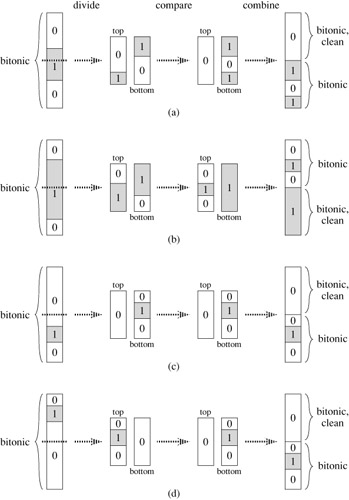| < Day Day Up > |
The first step in our construction of an efficient sorting network is to construct a comparison network that can sort any bitonic sequence: a sequence that monotonically increases and then monotonically decreases, or can be circularly shifted to become monotonically increasing and then monotonically decreasing. For example, the sequences <1, 4, 6, 8, 3, 2>, <6, 9, 4, 2, 3, 5>, and <9, 8, 3, 2, 4, 6> are all bitonic. As a boundary condition, we say that any sequence of just 1 or 2 numbers is bitonic. The zero-one sequences that are bitonic have a simple structure. They have the form 0i 1j 0k or the form 1i 0j 1k, for some i, j, k ≥ 0. Note that a sequence that is either monotonically increasing or monotonically decreasing is also bitonic.
The bitonic sorter that we shall construct is a comparison network that sorts bitonic sequences of 0's and 1's. Exercise 27.3-6 asks you to show that the bitonic sorter can sort bitonic sequences of arbitrary numbers.
A bitonic sorter is composed of several stages, each of which is called a half-cleaner. Each half-cleaner is a comparison network of depth 1 in which input line i is compared with line i + n/2 for i = 1, 2,..., n/2. (We assume that n is even.) Figure 27.7 shows HALF-CLEANER[8], the half-cleaner with 8 inputs and 8 outputs.

When a bitonic sequence of 0's and 1's is applied as input to a half-cleaner, the half-cleaner produces an output sequence in which smaller values are in the top half, larger values are in the bottom half, and both halves are bitonic. In fact, at least one of the halves is clean-consisting of either all 0's or all 1's-and it is from this property that we derive the name "half-cleaner." (Note that all clean sequences are bitonic.) The next lemma proves these properties of half-cleaners.
If the input to a half-cleaner is a bitonic sequence of 0's and 1's, then the output satisfies the following properties: both the top half and the bottom half are bitonic, every element in the top half is at least as small as every element of the bottom half, and at least one half is clean.
Proof The comparison network HALF-CLEANER[n] compares inputs i and i + n/2 for i = 1, 2,..., n/2. Without loss of generality, suppose that the input is of the form 00 ... 011 ... 100 ... 0. (The situation in which the input is of the form 11 ... 100 ... 011 ... 1 is symmetric.) There are three possible cases depending upon the block of consecutive 0's or 1's in which the midpoint n/2 falls, and one of these cases (the one in which the midpoint occurs in the block of 1's) is further split into two cases. The four cases are shown in Figure 27.8. In each case shown, the lemma holds.

By recursively combining half-cleaners, as shown in Figure 27.9, we can build a bitonic sorter, which is a network that sorts bitonic sequences. The first stage of BITONIC-SORTER[n] consists of HALF-CLEANER[n], which, by Lemma 27.3, produces two bitonic sequences of half the size such that every element in the top half is at least as small as every element in the bottom half. Thus, we can complete the sort by using two copies of BITONIC-SORTER[n/2] to sort the two halves recursively. In Figure 27.9(a), the recursion has been shown explicitly, and in Figure 27.9(b), the recursion has been unrolled to show the progressively smaller half-cleaners that make up the remainder of the bitonic sorter. The depth D(n) of BITONIC-SORTER[n] is given by the recurrence
whose solution is D(n) = lg n.

Thus, a zero-one bitonic sequence can be sorted by BITONIC-SORTER, which has a depth of lg n. It follows by the analog of the zero-one principle given as Exercise 27.3-6 that any bitonic sequence of arbitrary numbers can be sorted by this network.
Show that BITONIC-SORTER[n], where n is an exact power of 2, contains Θ(n lg n) comparators.
Describe how an O(lg n)-depth bitonic sorter can be constructed when the number n of inputs is not an exact power of 2.
If the input to a half-cleaner is a bitonic sequence of arbitrary numbers, prove that the output satisfies the following properties: both the top half and the bottom half are bitonic, and every element in the top half is at least as small as every element in the bottom half.
| < Day Day Up > |